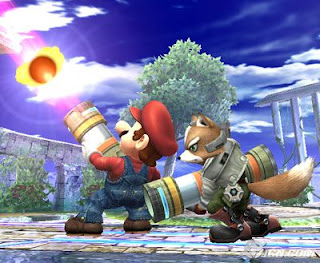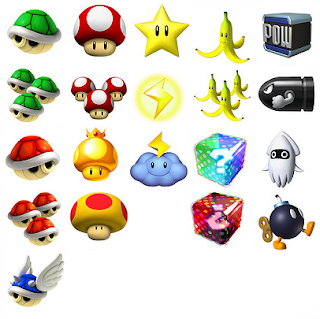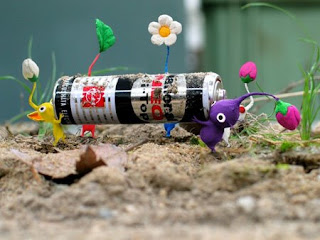Nintendo & Items
 Thursday, May 8, 2008 at 9:44AM
Thursday, May 8, 2008 at 9:44AM "Mario Kart has always teetered on the line of feeling somewhat orchestrated, as the racers in the lead receive items of little to no value while those in the back get items that will quickly jet them to the front. It adds to the chaotic "any race could be my race" feel..."
IGN- Mario Kart Wii
".... and "everyone's a winner" feeling you get when random items show up and completely turn the game upside down in an instant. Granted that's [Mario] Kart, but it's also a way to water down competition, which is exactly how Super Mario Kart got its start."
IGN - Mario Kart Wii
"Normal shots and even one-timers are highly unlikely against the spot-on goalie A.I., so players have to clear some space and sneak in a charged shot. Toss in a few shells, bomb drops and giant plumbers, and Charged becomes an incomprehensible riot. A hilarious riot, but an incomprehensible riot nonetheless."
Game Revolution - Mario Strikers Charged
"The game requires skill, but it also requires some patience and tolerance of its more random elements. Admittedly, this is not an entirely new thing in the Mario family of arcade sports games." 1up - Mario Strikers Charged
Nintendo arguably makes the best multiplayer games around. Simple rules. Family safe. Clean Visuals that reflect the design philosophy Form Fits Function. Great controls. And because of these factors, Nintendo games generally have a high level of emergent gameplay, which makes for an exciting metagames that evolves over time. Somehow, with over 15 years of experience with Nintendo games, people/reviews/and game enthusiasts have retained a poor understanding of how Nintendo games work.
It can be hard trying to wrap your mind around how Nintendo creates their multiplayer experiences if you come from a background of PC games or FPSs. With Nintendo games, stat upgrades, leveling up, and customizable equipment are no where to be found. Apart from these things, many Nintendo multiplayer games have one thing in common: items/power-ups. Mario is no stranger to power-ups. Even when he was scaling the tower to thwart the dastardly Kong, Mario had access to an all powerful Hammer power-up. From there Super Mario Brothers was designed with a variety of power-ups including the Mushroom, Star, and Fire Flower. Then on the Super Nintendo Mario Kart introduced the item box roulette that rewards the player with a random yet contextual power-up.
Now, many Nintendo games feature random items including the Super Smash Brothers series, Pikmin 2 (battle mode), the Mario Kart series, the Mario Strikers series, The Legend of Zelda: Four Swords (battle mode), The Legend of Zelda: Phantom Hourglass, New Super Mario Brothers (battle mode), Planet Puzzle League, Tetris DS, and Elite Beat Agents. Considering all these games yields some insight to how Nintendo multiplayer modes are designed.
First, the game rules and mechanics are created and refined. For a Mario Kart game this includes power sliding, racing, turning, hopping, bumping, terrain, and all the kart/character stats. For Smash Brothers this includes walking, running, jumping, attacking, and taunting. For a game like Elite Beat Agents, Tetris, or Planet Puzzle League, all the familiar single player controls, mechanics, and rules apply.
After the game system has been established and polished, developers love to add in a small random element into the game. At best, when a random element is thrown into the mix, it enhances the multiplayer experience in a number of ways. The random item transforms the game by shifting the parameters of the goal slightly, creating a new obstacle/hazard, or adjusting the strategic options available for the players. A banana waiting on a short cut ramp in a Mario Kart race can disable the short cut.
Grabbing a Star power-up in Smash Brothers puts one player on the offensive and all the other characters on the defensive. In this way, not only does the power-up transform the game, but it challenge's both players ability to understand the mechanics of the power-up, the rules of the game, and to adapt and react on the fly.
When an item/power-up is properly designed, they increase the skill needed to successfully compete. Even when an item is randomly dropped into a match, it can test a players reaction times, adaptability, and knowledge of the game. When a game is built off of a few simple rules, having to adapt to new conditions is a highly effective way to keep things fresh and simple while challenging both players.
Some games create systems where player have to earn their items. Mario Kart racers have to drive through item boxes. Tetris players have to eliminate lines that contain a small item box square. In Elite Beat Agents players have to score a series of perfect runs. In Mario Strikers, if a player is flagrantly tackled, they are compensated with an item. This keeps the game fast and fluid without stopping for penalty kicks and the like. Otherwise, a player can earn their own items by charging a shot on the goal without using their special shot. Because the special shots are generally more effective at scoring goals, there's a trade off between a potential goal and obtaining an item.

Unfortunately, Masahiro Sakurai didn't feel like it was necessary for players to be able to earn items on their own. Out of all the games on the list, the Smash Brothers games are the only games that have randomly spawning items that instantly effect the game without being used by any player. It's true, a bomb can randomly explode on a player without warning. This is a poor design choice that has continued with the Smash Brothers series. Because items are so dangerous existing at times outside of player control, they have been banned from the vast majority of Smash Brothers tournaments for many years now.
Mario Strikers Charged for the Nintendo Wii is the best example of a modern Nintendo game that has an item system that is designed correctly and is well balanced. By rewarding victims from dirty plays, and giving the player the chance to earn their own items, items are a direct result of the all the players actions. Also, to earn your own item, you have to have the ball. This puts a limit on the amount of "item farming" the player can do at any one time. Lastly, even when the field gets completely overrun with items, after each goal, everything is cleared.
Nintendo has certainly has been successful doing things their own way. Though I would much rather have more organic ways of incorporating "random items" into the multiplayer design, the progress Nintendo has made thus far still gives them an edge on the competition.



